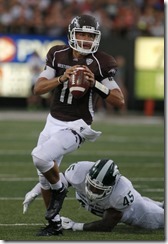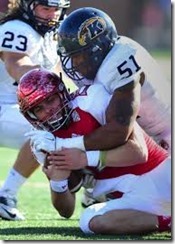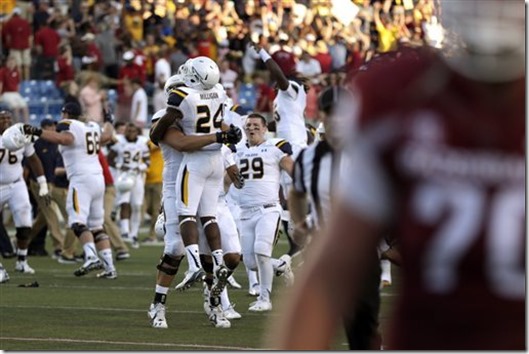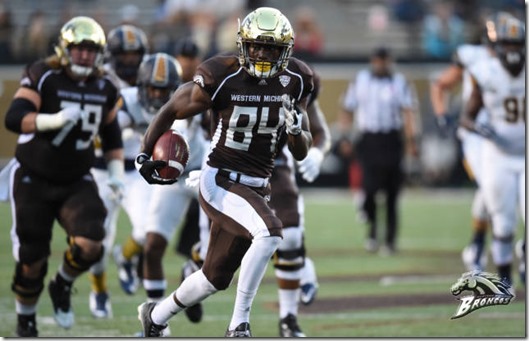Left to right: WMU’s Zach Terrell, Ohio’s Frank Solich, Kent State’s Terence Waugh
College football’s still a ways away, but now that we’re getting close to Memorial Day – when the national preview magazines start appearing at bookstores – we might as well take a look at the CFB landscape. While the sport’s third estate won’t receive as much ink as the superpowers and the playoff race, the mid-major conferences around the country are part of what makes college football so great. Now that the sport is divided into the Power 5 and Group of 5, there’s a decided hierarchy for the have-nots, but at least one of them is guaranteed a game against one of the big boys in a New Year’s Six Bowl. For the true college football fan, at least a cursory knowledge of the Group of 5 conferences is a must. Because of their regional proximity to the Big Ten, I’ll start with the MAC.
[article after the JUMP]
PJ Fleck, maybe the next in line to get a big promotion in the coaching world
What’s Special?
The MAC is known for providing coaches with stepping-stone jobs on their way to greatness, but oftentimes, the first fruits of the MAC coaching fraternity are usually swept up by lower-tier Power 5 jobs with hard roads to success. Most then get Peter Principled. This past coaching carousel saw Toledo and Bowling Green lose very good coaching prospects to Iowa State and Syracuse, respectively. Whether Matt Campbell and Dino Babers succeed at those new jobs or not, one thing’s for sure: bigger schools will always look to the MAC for coaches, so there will always be attrition at the top in what’s been generally a very homogenous and egalitarian league, historically. The biggest name right now is Western Michigan’s PJ Fleck, who recruits extremely well and may be smartly holding out for a bigger job than the mediocre high-major names he’s been linked with.
Anyways, the “Cradle of Coaches” moniker is not the best thing about the MAC – that would be what’s affectionately known as #MACtion, a unique brand of high-octane football played on cold mid-week nights across the Midwest. The MAC has staked out the least-desirable TV slots for their conference games – understandably, as the only way that a game featuring two random Group of 5 teams makes it onto ESPN is if they’re playing on like a Tuesday night – and those usually competitive and typically entertaining games have become a Thing for a more serious portion of the CFB viewing populace. It doesn’t even really take the relatively big names to make for good matchups, though late-season games between division title contenders have the potential to be truly excellent. For those who love the bountifulness of the modern college football viewer’s guide, #MACtion is a small but imperative piece of the pie. Let us all be thankful that the MAC is willing to step up and ably fill the college football void from the late-night Saturday games to the now-customary Thursday night fare.
Coach Dino Babers and quarterback Matt Johnson, formerly of Bowling Green
2015 Recap
In 2015, the class of the conference was Bowling Green. Led by Dino Babers, a branch of the Art Briles coaching tree, the Falcons had a predictably potent offense, defeated two Big Ten teams (Maryland and Purdue, but still), and coasted by Northern Illinois with ease in the conference championship game – the third straight matchup between the two (BGSU is 2-1). Bowling Green wasn’t the only MAC team to pull a notable road upset in September, as Toledo defeated Bret Bielema and Arkansas by the wonderful football score of 16-12. The Rockets – a BGSU rival (though in the opposite division) – were the only MAC team to defeat the Falcons last season.
The West was a mess: four teams (Northern Illinois, Western and Central Michigan, and Toledo) finished with identical 6-2 league records, which handed the division title to NIU, who had just one intradivision loss. While Northern Illinois retained its stranglehold on the division, Toledo was probably its best team; two MAC teams finished in the final F/+ top 25 – Toledo ranked 21st, Bowling Green 25th. Toledo actually received proper attention from the traditional polls, as they were ranked at the time of both of their losses to NIU and WMU. A bowl win over a very solid Temple squad after the departure of head coach Matt Campbell was probably the highlight of the MAC’s bowl season – Western Michigan and Akron each won their first bowl in program history.
Central Michigan quarterback Cooper Rush during one of the MAC’s biggest rivalry games
League Structure
The conference is split into tidy six-team divisions: East and West. Every team that’s in the MAC has been in the league since at least 1998, though there have been a few teams that entered and quickly exited within that time – Marshall, UCF, Temple, and UMass. Central Florida’s time in the MAC is still a head-scratcher, but I guess their three-year stint in a Rust Belt conference was the first in a slow climb up the conference ladder. George O’Leary’s first season (of what would eventually be a decade-long tenure) at UCF was the Black Knights’ last in the MAC before managing to move to the Conference-USA. In that 2004 campaign, they went 0-11.
Nowadays, the East has five of the six MAC teams from Ohio (Akron, Kent State, Miami, Ohio, Bowling Green) as well as Buffalo. Toledo is in the West with the directional Michigan schools – Central, Eastern, Western – along with Ball State and Northern Illinois. The MAC Championship is held annually at Ford Field, and the conference champ isn’t automatically slated for any particular bowl.
Toledo players celebrate on the field following a stunning win on the road over Arkansas
Shots at Goliath
As usual, the MAC is paid to serve as September cannon fodder for the Big Ten (there are seven games total between the two conferences this year). If that seems like fewer than normal, the Big Ten’s move to a schedule with nine conference games (and thus only three non-conference games) may be why.
14 games against Power 5 conferences in all:
- Western Michigan @ Northwestern (B1G)
- Bowling Green @ Ohio State (B1G)
- Kent State @ Penn State (B1G)
- Miami @ Iowa (B1G)
- Akron @ Wisconsin (B1G)
- Ohio @ Kansas (Big 12)
- Ball State @ Indiana (B1G)
- Central Michigan @ Oklahoma State (Big 12)
- Eastern Michigan @ Missouri (SEC)
- Western Michigan @ Illinois (B1G)
- Ohio @ Tennessee (SEC)
- Central Michigan @ Virginia (ACC)
- Kent State @ Alabama (SEC)
- Buffalo @ Boston College (ACC)
The Underdog Bites Back? Maybe?
Ohio vs. Kansas jumps out immediately because the Jayhawks are still a D-II program digging out of the Charlie Weis trailer. I wonder if Frank Solich has fond memories of Lawrence. Anyways, as far as games featuring real Power 5 teams go, Western Michigan’s two trips down 94 into the Land of Lincoln should be interesting: the Broncos face Northwestern in the season opener – strength-on-strength in that one between WMU’s O and NU’s D – and Illinois a few weeks later. Western getting a win against Lovie Smith’s first Illini team is likelier, but an upset against Northwestern (fresh off a ten-win season) is also possible.
Otherwise, there aren’t really any other obvious candidates. Missouri was just wretched on offense last year and would be given scares (or L’s) by a couple different MAC teams, but not Eastern. Boston College is another offensively dysfunctional Power 5 outfit, and perhaps Buffalo – in its second year under Lance Leipold, the former Wisconsin-Whitewater D-III Dynasty guy – will give them a good fight. Northern Illinois did last year, but ultimately fell short by a field goal.
Just Take the Check and Oh No There’s Blood Everywhere
Well, Bowling Green was legit good last seas— okay, yeah, we’ve seen Ohio State feast on their in-state MACrifices before. However, Kent State traveling to Tuscaloosa to face a hyper-talented reigning national champ is worse. Godspeed, Golden Flashes.
Dynamic WMU receiver Corey Davis will get even more targets in 2016
3 Teams to Watch
Bowling Green
While the reigning conference champs must replace a very good head coach, there’s still good reasons for optimism in Bowling Green: Dino Babers thrived quickly after replacing Dave Clawson, there’s some degree of consistency between he and his replacement, Mike Jinks (another pass-happy Air Raid acolyte), and most importantly, the Falcons find themselves in the lesser of the two MAC divisions. Despite losing a ton of excellent skill-position players, BGSU returns most of what was a great offensive line – surely they’ll experience some growing pains early, but the potential for another really good offense is there. Jinks was a high school coach as recently as a few years ago and doesn’t have any Midwestern ties, so there might be some transitional issues, but ultimately he’s walking into the best situation (in paper) in the MAC East and he’s tasked with keeping the program in cruise control, not building something from scratch.
Northern Illinois
Even though they weren’t competitive in a conference championship loss to Bowling Green (and they were just utterly destroyed by Boise State in their bowl game), there’s still good reason to think that Northern Illinois will be in the thick of the MAC championship race again this year: the Huskies have won the MAC West six times in a row, winning the league in three of those seasons (and receiving the MAC’s only BCS Bowl ever). Last year, NIU was competitive – though strangely conservative – in a close loss to Ohio State, but by the end of the season, they were onto their fourth quarterback, a freshman walk-on. Drew Hare, a dynamic dual-threat quarterback recovering from an Achilles injury, is the front-runner to lead the offense; in recent years, the Huskies have developed an attacking small-but-fast defense that’s well-equipped to handle the style of many MAC opponents. While Toledo or WMU might be better bets to win the MAC West, NIU is still at the heart of the discussion until proven otherwise.
Western Michigan
The best Directional Michigan MAC Team looks to be Western (sorry Central), as PJ Fleck will start enjoying the fruits of a roster comprised almost entirely by his own relatively highly-rated recruiting classes. The Broncos have continually signed the best classes in the MAC during Fleck’s tenure, and the talent advantage they have should pay dividends yet again – mostly on the back of what should be a powerful and balanced offense. They return All-MAC candidates at quarterback and receiver in Zach Terrell and Corey Davis, and boast a strong running back tandem in Jamauri Bogan and Jarvion Franklin; most of a stable offensive line returns, though the best lineman (LT Willie Beavers) graduated. Western’s defense has worryingly plateaued at mediocre as its offense has improved year-over-year under Fleck – perhaps a bevy of returning starters will see an experience bump. Last year, Western faced Michigan State and Ohio State in non-conference play, and get Northwestern and Illinois this year, which is a considerable upgrade. With an upset or two, WMU could quickly stake a claim as one of the frontrunners for a spot as the Group of 5’s New Year’s Six representative.







